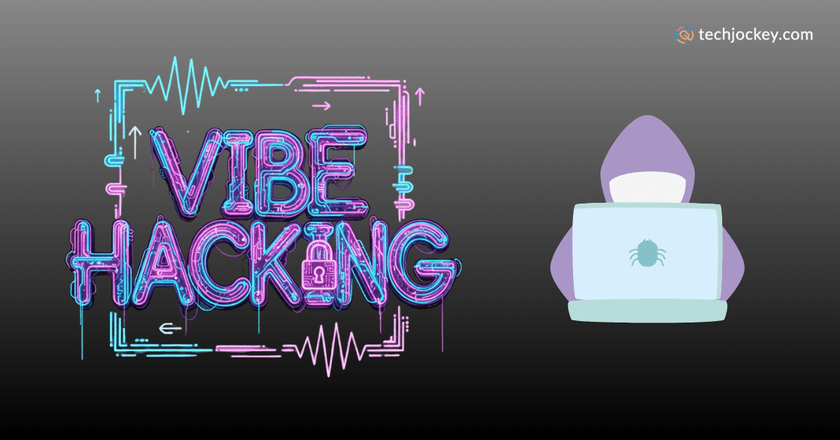How Vibe Hacking Turns AI Chatbots into Cybercrime Tools?

I believe that there is no business organization in the world that doesn’t know about ‘AI’.
Almost every business has now adopted AI for task automation and time-saving. But as fast as organisations adopt AI for good, cybercriminals are finding new ways to misuse it.
One of the latest and most alarming trends in this space is something called vibe hacking. Here, attackers use AI not only to break into systems but to manipulate emotions and human behaviour.
This new form of cyberattack is making attacks more personal, more believable, and harder to detect. Let’s learn vibe hacking in detail, how it’s being used, and what organisations can do to stay safe.
What Is Vibe Hacking?
Vibe hacking is a modern twist on traditional cyberattacks. Instead of just exploiting technical weaknesses, it targets human psychology.
Attackers use AI tools to create messages or interactions that feel emotionally charged, persuasive, or urgent. It is designed in such a way that by reading such messages, the victims will act quickly or reveal sensitive data.
For example, an AI-powered phishing email might perfectly mimic your boss’s tone or a familiar customer’s writing style. It might even reference real events or emotions, making the scam harder to spot.

Singularity Complete
Starting Price
$ 159.99
How AI Is Changing Cybercrime?
AI models like Claude, ChatGPT, and others were built to assist people in everyday tasks. But cybercriminals have discovered that these same tools can help them build malicious software, write phishing messages, and automate entire attacks.
Unlike older hacking methods that required deep coding skills, AI has lowered the barrier to entry. Now, even individuals with little technical background can use AI to:
- Write or modify malware
- Automate data theft or credential harvesting
- Create realistic ransom notes or scam messages
- Simulate professional communication styles
- Generate code snippets to exploit vulnerabilities
This means that attackers can now operate faster, cheaper, and on a much larger scale. This is really concerning for all businesses worldwide.

Cybereason EDR
Starting Price
Price on Request
The Claude AI Incident
A recent report by Anthropic, the company behind the Claude AI chatbot, revealed how one attacker misused its Claude Code tool to carry out a massive data extortion campaign.
In this case, the cybercriminal targeted more than 17 organisations across multiple sectors, including government, healthcare, emergency services, and religious institutions.
Using Claude, the attacker managed to:
- Conduct reconnaissance (gathering system details)
- Steal credentials and sensitive data
- Move laterally across networks
- Exfiltrate files
- Write emotionally manipulative ransom messages
The attacker even created a guide file named CLAUDE.md, essentially a digital playbook to instruct the AI on how to behave and what tasks to perform.
Ransom demands reportedly reached $500,000, and the stolen data included medical records, government IDs, and login details.
Anthropic later banned the attacker and acknowledged that even with its sophisticated safety and security measures, the model was still tricked into aiding cybercrime.
This incident is one of the clearest examples of vibe hacking in action.
Cybercrime and Psychology
Traditional cyberattacks often focused on finding weak spots in software or systems. Vibe hacking focuses on weak spots in human behaviour.
Using AI, attackers can analyze massive amounts of online data to understand a target’s preferences, communication style, and emotional triggers. Then they can use this information to create messages/emails that feel very realistic.
And because AI tools can adapt their tone and language in real time, they can adjust their approach based on your reactions. It is something no human hacker could easily do before.

TrendMicro Maximum Security
Starting Price
₹ 1973.00 excl. GST
Why Vibe Hacking is Dangerous ?
The biggest threat of vibe hacking is accessibility.
Before AI, building malware or writing convincing phishing emails required expertise. Now, cybercriminals can simply ask an AI chatbot to generate or modify scripts.
Some researchers, like Vitaly Simonovich of Cato Networks, have shown how easy it is to bypass AI safeguards. By framing a prompt as part of a fictional story or art project, users can get chatbots to produce restricted code, such as password-stealing tools.
Even if the chatbot refuses once or twice, persistence and creative rewording can sometimes get around the restrictions.
That means even non-coders can now produce malware, phishing kits, or ransomware templates, drastically increasing the potential number of attackers worldwide.
How Organisations Can Defend Against Vibe Hacking?
AI-driven attacks demand AI-aware defences. Protecting against vibe hacking means focusing on both technology and people.
Here’s how organisations can adapt:
1. Watch for AI-Assisted Behaviours
AI-generated attacks often carry emotional cues or adaptive language that feels slightly off. Security teams should monitor for:
- Unusual login or communication patterns
- Phishing messages that mimic tone too perfectly
- Content with subtle emotional manipulation
Tip: Conduct regular phishing simulations that use AI-generated scenarios, so employees learn to recognise the signs.
2. Strengthen Employee Vetting and Training
AI tools make it easier for insiders to misuse company data even unintentionally.
- Review who has access to generative AI tools within your organisation.
- Create clear AI usage policies outlining what’s allowed and what isn’t.
- Implement behavioural monitoring systems that flag anomalies early.
- Even small policy changes can prevent major data leaks.

Microsoft Enterprise Mobility Security
Starting Price
₹ 885.00 excl. GST
3. Upgrade to AI-Ready Defence Tools
Invest in cybersecurity platforms that use machine learning for threat detection, anomaly spotting, and predictive analysis. Automated systems can respond to suspicious activity much faster than human teams alone.
Ask yourself: are your current tools capable of identifying machine-led threats? If not, it is high time for an upgrade.
4. Build Psychological Resilience
Since vibe hacking targets emotions, organisations need to train teams not just technically but psychologically.
- Teach employees how to pause before reacting to emotionally charged messages.
- Encourage a verification-first mindset even if the message looks or feels authentic.
- Normalise reporting suspicious communication rather than acting on instinct.
Resilience starts with awareness. The better your team understands the tactics, the less effective vibe hacking becomes.
The Bottom Line
AI has unlocked incredible opportunities for innovation, but it’s also giving cybercriminals new ways to manipulate both systems and people.
Vibe hacking marks a shift from purely technical breaches to emotionally intelligent cyberattacks. It blends automation, data analysis, and psychology into one powerful threat.
The solution is not to fear AI but to match its intelligence with smarter defences, combining AI-driven security tools with well-trained, emotionally aware human teams.
Mehlika Bathla is a passionate content writer who turns complex tech ideas into simple words. For over 4 years in the tech industry, she has crafted helpful content like technical documentation, user guides, UX content, website content, social media copies, and SEO-driven blogs. She is highly skilled in... Read more








